Communication in Organizations: Applying Theories and Analysis
VerifiedAdded on 2023/06/12
|8
|1690
|495
Essay
AI Summary
This essay examines communication processes within organizations, applying theories such as the transactional communication model, social penetration theory, and attribution theory to a real-world scenario observed in a retail setting. The analysis focuses on a communication event involving a salesman, a customer, and a supervisor, highlighting the impact of factors like noise, self-disclosure, and nonverbal cues on the effectiveness of communication. The essay also explores the role of attribution in understanding behavior and motivation in the workplace, referencing various studies and research to support its findings. Ultimately, the essay emphasizes the importance of understanding the underlying frameworks that govern everyday conversations and interactions in organizational contexts.
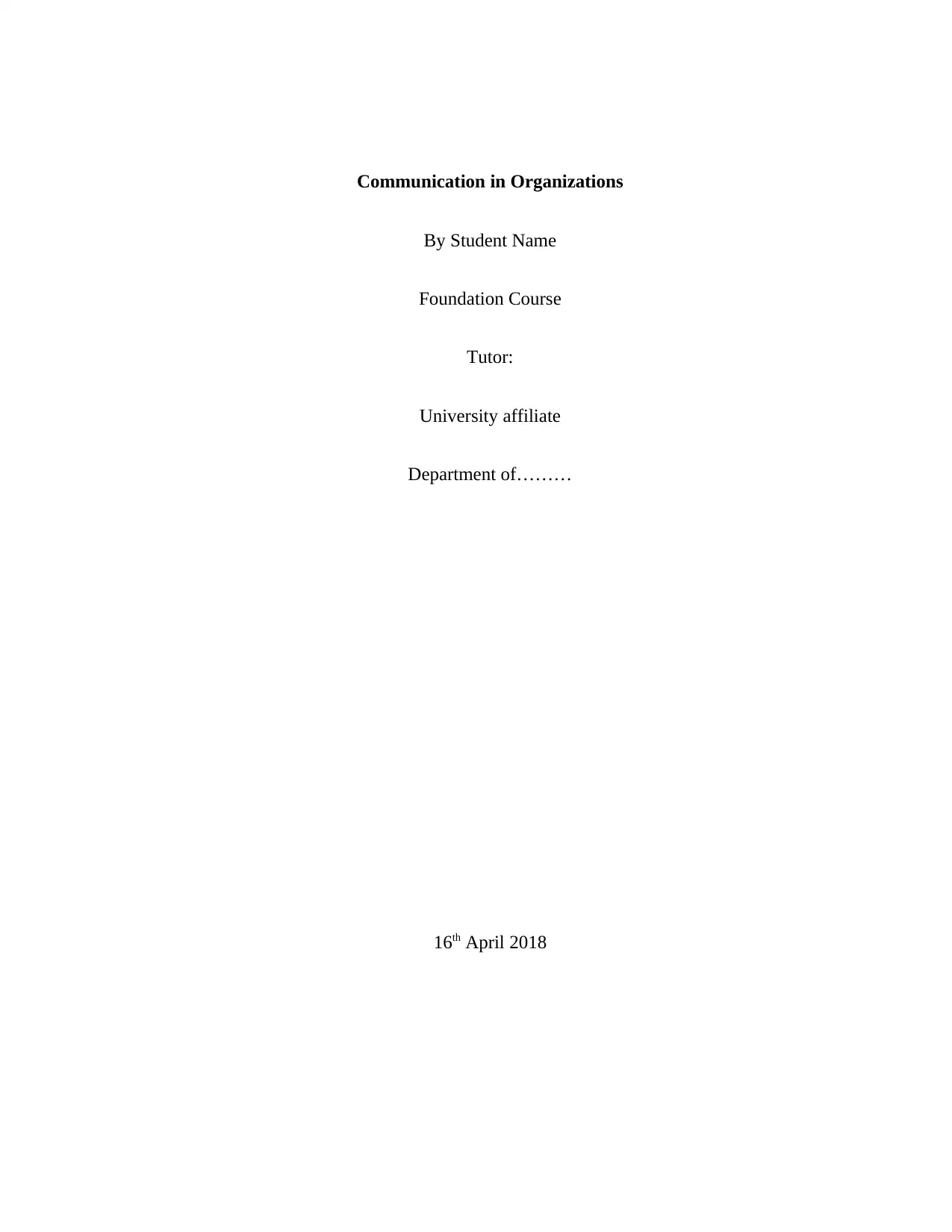
Communication in Organizations
By Student Name
Foundation Course
Tutor:
University affiliate
Department of………
16th April 2018
By Student Name
Foundation Course
Tutor:
University affiliate
Department of………
16th April 2018
Paraphrase This Document
Need a fresh take? Get an instant paraphrase of this document with our AI Paraphraser
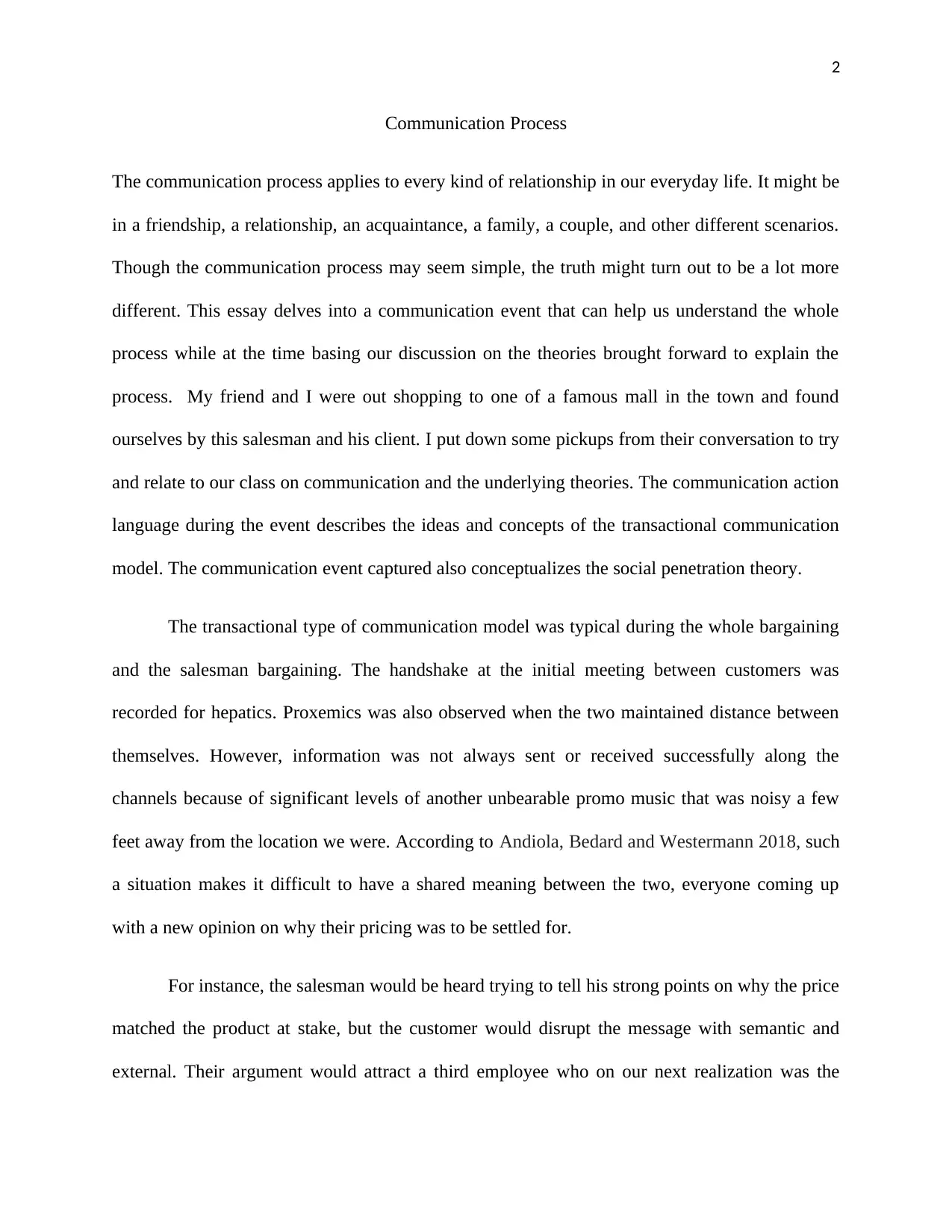
2
Communication Process
The communication process applies to every kind of relationship in our everyday life. It might be
in a friendship, a relationship, an acquaintance, a family, a couple, and other different scenarios.
Though the communication process may seem simple, the truth might turn out to be a lot more
different. This essay delves into a communication event that can help us understand the whole
process while at the time basing our discussion on the theories brought forward to explain the
process. My friend and I were out shopping to one of a famous mall in the town and found
ourselves by this salesman and his client. I put down some pickups from their conversation to try
and relate to our class on communication and the underlying theories. The communication action
language during the event describes the ideas and concepts of the transactional communication
model. The communication event captured also conceptualizes the social penetration theory.
The transactional type of communication model was typical during the whole bargaining
and the salesman bargaining. The handshake at the initial meeting between customers was
recorded for hepatics. Proxemics was also observed when the two maintained distance between
themselves. However, information was not always sent or received successfully along the
channels because of significant levels of another unbearable promo music that was noisy a few
feet away from the location we were. According to Andiola, Bedard and Westermann 2018, such
a situation makes it difficult to have a shared meaning between the two, everyone coming up
with a new opinion on why their pricing was to be settled for.
For instance, the salesman would be heard trying to tell his strong points on why the price
matched the product at stake, but the customer would disrupt the message with semantic and
external. Their argument would attract a third employee who on our next realization was the
Communication Process
The communication process applies to every kind of relationship in our everyday life. It might be
in a friendship, a relationship, an acquaintance, a family, a couple, and other different scenarios.
Though the communication process may seem simple, the truth might turn out to be a lot more
different. This essay delves into a communication event that can help us understand the whole
process while at the time basing our discussion on the theories brought forward to explain the
process. My friend and I were out shopping to one of a famous mall in the town and found
ourselves by this salesman and his client. I put down some pickups from their conversation to try
and relate to our class on communication and the underlying theories. The communication action
language during the event describes the ideas and concepts of the transactional communication
model. The communication event captured also conceptualizes the social penetration theory.
The transactional type of communication model was typical during the whole bargaining
and the salesman bargaining. The handshake at the initial meeting between customers was
recorded for hepatics. Proxemics was also observed when the two maintained distance between
themselves. However, information was not always sent or received successfully along the
channels because of significant levels of another unbearable promo music that was noisy a few
feet away from the location we were. According to Andiola, Bedard and Westermann 2018, such
a situation makes it difficult to have a shared meaning between the two, everyone coming up
with a new opinion on why their pricing was to be settled for.
For instance, the salesman would be heard trying to tell his strong points on why the price
matched the product at stake, but the customer would disrupt the message with semantic and
external. Their argument would attract a third employee who on our next realization was the
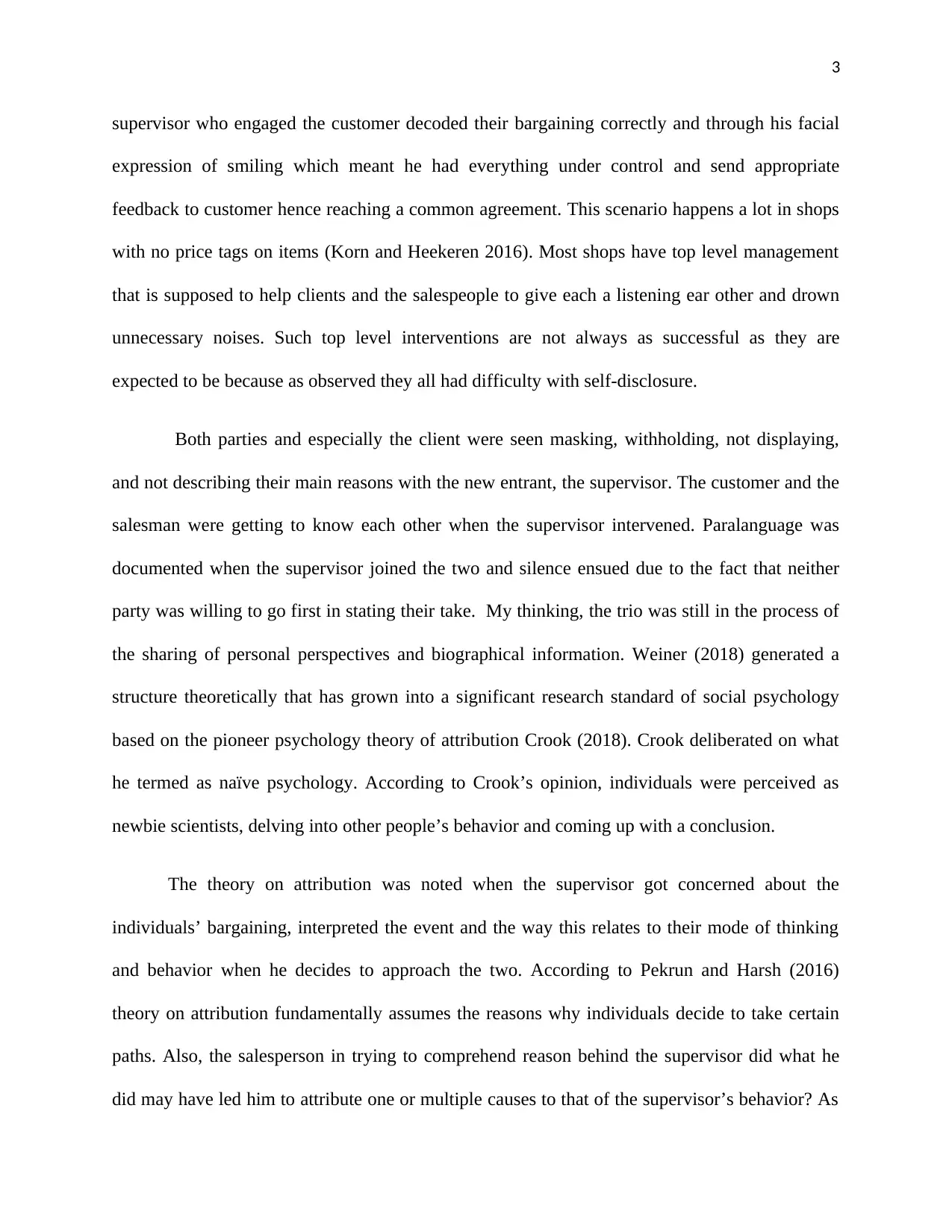
3
supervisor who engaged the customer decoded their bargaining correctly and through his facial
expression of smiling which meant he had everything under control and send appropriate
feedback to customer hence reaching a common agreement. This scenario happens a lot in shops
with no price tags on items (Korn and Heekeren 2016). Most shops have top level management
that is supposed to help clients and the salespeople to give each a listening ear other and drown
unnecessary noises. Such top level interventions are not always as successful as they are
expected to be because as observed they all had difficulty with self-disclosure.
Both parties and especially the client were seen masking, withholding, not displaying,
and not describing their main reasons with the new entrant, the supervisor. The customer and the
salesman were getting to know each other when the supervisor intervened. Paralanguage was
documented when the supervisor joined the two and silence ensued due to the fact that neither
party was willing to go first in stating their take. My thinking, the trio was still in the process of
the sharing of personal perspectives and biographical information. Weiner (2018) generated a
structure theoretically that has grown into a significant research standard of social psychology
based on the pioneer psychology theory of attribution Crook (2018). Crook deliberated on what
he termed as naïve psychology. According to Crook’s opinion, individuals were perceived as
newbie scientists, delving into other people’s behavior and coming up with a conclusion.
The theory on attribution was noted when the supervisor got concerned about the
individuals’ bargaining, interpreted the event and the way this relates to their mode of thinking
and behavior when he decides to approach the two. According to Pekrun and Harsh (2016)
theory on attribution fundamentally assumes the reasons why individuals decide to take certain
paths. Also, the salesperson in trying to comprehend reason behind the supervisor did what he
did may have led him to attribute one or multiple causes to that of the supervisor’s behavior? As
supervisor who engaged the customer decoded their bargaining correctly and through his facial
expression of smiling which meant he had everything under control and send appropriate
feedback to customer hence reaching a common agreement. This scenario happens a lot in shops
with no price tags on items (Korn and Heekeren 2016). Most shops have top level management
that is supposed to help clients and the salespeople to give each a listening ear other and drown
unnecessary noises. Such top level interventions are not always as successful as they are
expected to be because as observed they all had difficulty with self-disclosure.
Both parties and especially the client were seen masking, withholding, not displaying,
and not describing their main reasons with the new entrant, the supervisor. The customer and the
salesman were getting to know each other when the supervisor intervened. Paralanguage was
documented when the supervisor joined the two and silence ensued due to the fact that neither
party was willing to go first in stating their take. My thinking, the trio was still in the process of
the sharing of personal perspectives and biographical information. Weiner (2018) generated a
structure theoretically that has grown into a significant research standard of social psychology
based on the pioneer psychology theory of attribution Crook (2018). Crook deliberated on what
he termed as naïve psychology. According to Crook’s opinion, individuals were perceived as
newbie scientists, delving into other people’s behavior and coming up with a conclusion.
The theory on attribution was noted when the supervisor got concerned about the
individuals’ bargaining, interpreted the event and the way this relates to their mode of thinking
and behavior when he decides to approach the two. According to Pekrun and Harsh (2016)
theory on attribution fundamentally assumes the reasons why individuals decide to take certain
paths. Also, the salesperson in trying to comprehend reason behind the supervisor did what he
did may have led him to attribute one or multiple causes to that of the supervisor’s behavior? As
⊘ This is a preview!⊘
Do you want full access?
Subscribe today to unlock all pages.

Trusted by 1+ million students worldwide
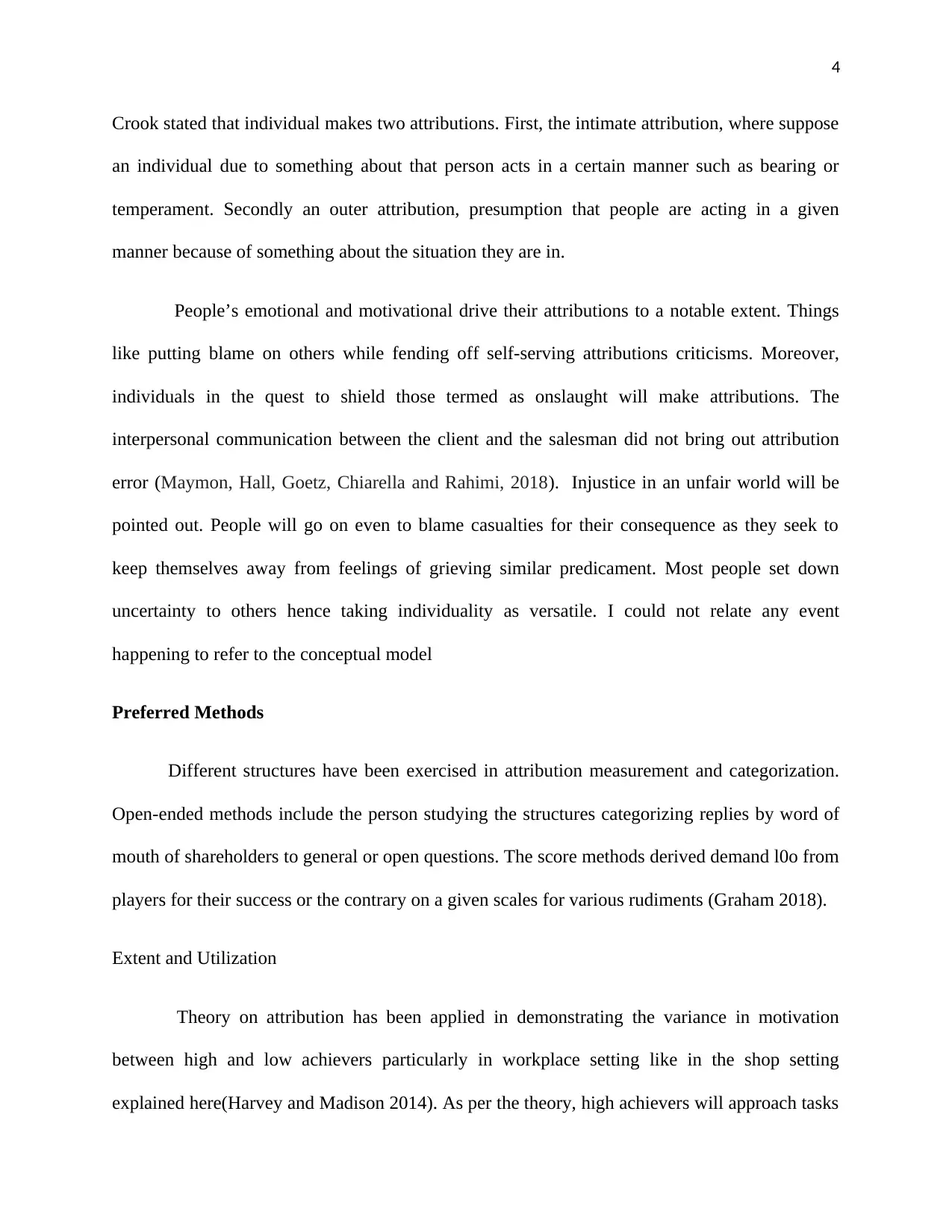
4
Crook stated that individual makes two attributions. First, the intimate attribution, where suppose
an individual due to something about that person acts in a certain manner such as bearing or
temperament. Secondly an outer attribution, presumption that people are acting in a given
manner because of something about the situation they are in.
People’s emotional and motivational drive their attributions to a notable extent. Things
like putting blame on others while fending off self-serving attributions criticisms. Moreover,
individuals in the quest to shield those termed as onslaught will make attributions. The
interpersonal communication between the client and the salesman did not bring out attribution
error (Maymon, Hall, Goetz, Chiarella and Rahimi, 2018). Injustice in an unfair world will be
pointed out. People will go on even to blame casualties for their consequence as they seek to
keep themselves away from feelings of grieving similar predicament. Most people set down
uncertainty to others hence taking individuality as versatile. I could not relate any event
happening to refer to the conceptual model
Preferred Methods
Different structures have been exercised in attribution measurement and categorization.
Open-ended methods include the person studying the structures categorizing replies by word of
mouth of shareholders to general or open questions. The score methods derived demand l0o from
players for their success or the contrary on a given scales for various rudiments (Graham 2018).
Extent and Utilization
Theory on attribution has been applied in demonstrating the variance in motivation
between high and low achievers particularly in workplace setting like in the shop setting
explained here(Harvey and Madison 2014). As per the theory, high achievers will approach tasks
Crook stated that individual makes two attributions. First, the intimate attribution, where suppose
an individual due to something about that person acts in a certain manner such as bearing or
temperament. Secondly an outer attribution, presumption that people are acting in a given
manner because of something about the situation they are in.
People’s emotional and motivational drive their attributions to a notable extent. Things
like putting blame on others while fending off self-serving attributions criticisms. Moreover,
individuals in the quest to shield those termed as onslaught will make attributions. The
interpersonal communication between the client and the salesman did not bring out attribution
error (Maymon, Hall, Goetz, Chiarella and Rahimi, 2018). Injustice in an unfair world will be
pointed out. People will go on even to blame casualties for their consequence as they seek to
keep themselves away from feelings of grieving similar predicament. Most people set down
uncertainty to others hence taking individuality as versatile. I could not relate any event
happening to refer to the conceptual model
Preferred Methods
Different structures have been exercised in attribution measurement and categorization.
Open-ended methods include the person studying the structures categorizing replies by word of
mouth of shareholders to general or open questions. The score methods derived demand l0o from
players for their success or the contrary on a given scales for various rudiments (Graham 2018).
Extent and Utilization
Theory on attribution has been applied in demonstrating the variance in motivation
between high and low achievers particularly in workplace setting like in the shop setting
explained here(Harvey and Madison 2014). As per the theory, high achievers will approach tasks
Paraphrase This Document
Need a fresh take? Get an instant paraphrase of this document with our AI Paraphraser
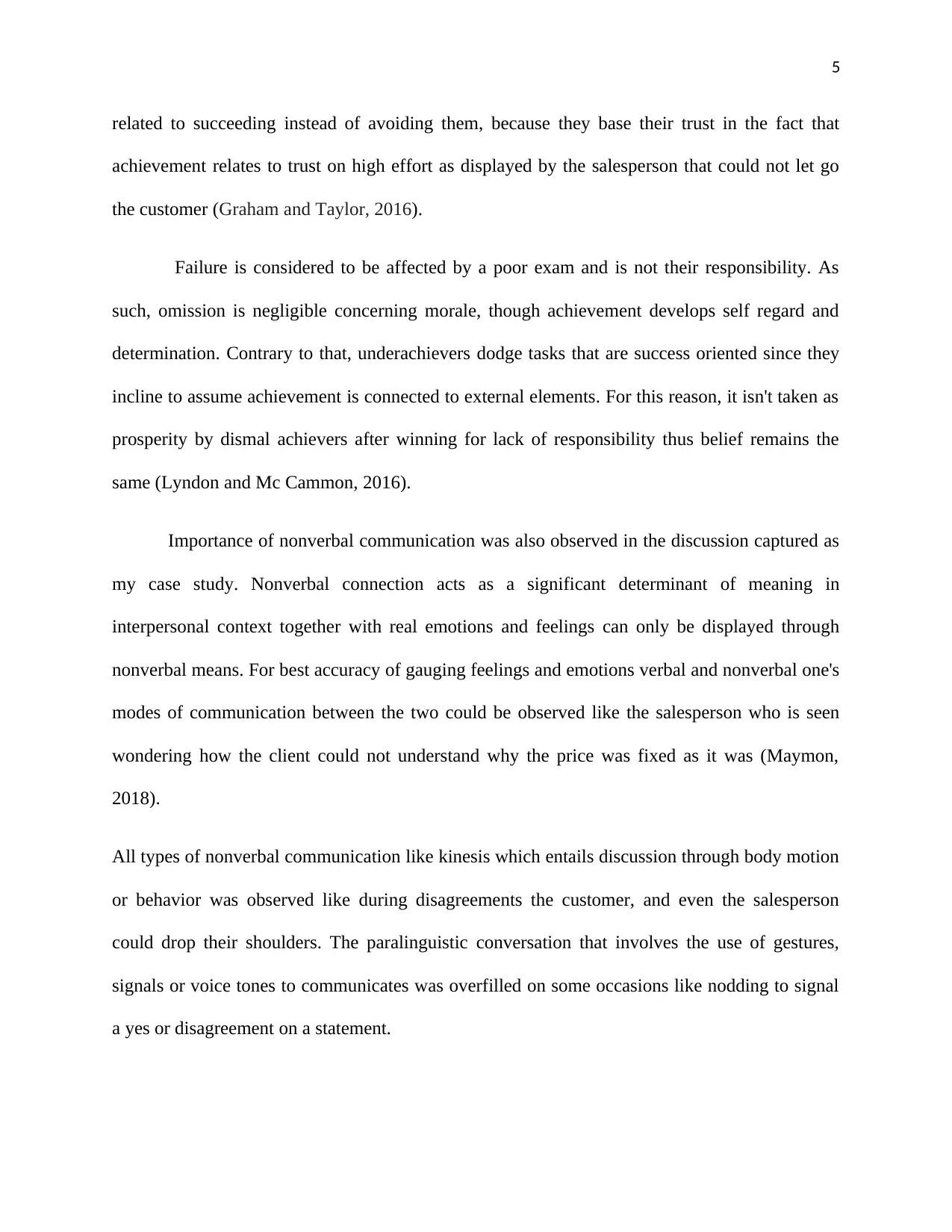
5
related to succeeding instead of avoiding them, because they base their trust in the fact that
achievement relates to trust on high effort as displayed by the salesperson that could not let go
the customer (Graham and Taylor, 2016).
Failure is considered to be affected by a poor exam and is not their responsibility. As
such, omission is negligible concerning morale, though achievement develops self regard and
determination. Contrary to that, underachievers dodge tasks that are success oriented since they
incline to assume achievement is connected to external elements. For this reason, it isn't taken as
prosperity by dismal achievers after winning for lack of responsibility thus belief remains the
same (Lyndon and Mc Cammon, 2016).
Importance of nonverbal communication was also observed in the discussion captured as
my case study. Nonverbal connection acts as a significant determinant of meaning in
interpersonal context together with real emotions and feelings can only be displayed through
nonverbal means. For best accuracy of gauging feelings and emotions verbal and nonverbal one's
modes of communication between the two could be observed like the salesperson who is seen
wondering how the client could not understand why the price was fixed as it was (Maymon,
2018).
All types of nonverbal communication like kinesis which entails discussion through body motion
or behavior was observed like during disagreements the customer, and even the salesperson
could drop their shoulders. The paralinguistic conversation that involves the use of gestures,
signals or voice tones to communicates was overfilled on some occasions like nodding to signal
a yes or disagreement on a statement.
related to succeeding instead of avoiding them, because they base their trust in the fact that
achievement relates to trust on high effort as displayed by the salesperson that could not let go
the customer (Graham and Taylor, 2016).
Failure is considered to be affected by a poor exam and is not their responsibility. As
such, omission is negligible concerning morale, though achievement develops self regard and
determination. Contrary to that, underachievers dodge tasks that are success oriented since they
incline to assume achievement is connected to external elements. For this reason, it isn't taken as
prosperity by dismal achievers after winning for lack of responsibility thus belief remains the
same (Lyndon and Mc Cammon, 2016).
Importance of nonverbal communication was also observed in the discussion captured as
my case study. Nonverbal connection acts as a significant determinant of meaning in
interpersonal context together with real emotions and feelings can only be displayed through
nonverbal means. For best accuracy of gauging feelings and emotions verbal and nonverbal one's
modes of communication between the two could be observed like the salesperson who is seen
wondering how the client could not understand why the price was fixed as it was (Maymon,
2018).
All types of nonverbal communication like kinesis which entails discussion through body motion
or behavior was observed like during disagreements the customer, and even the salesperson
could drop their shoulders. The paralinguistic conversation that involves the use of gestures,
signals or voice tones to communicates was overfilled on some occasions like nodding to signal
a yes or disagreement on a statement.

6
In conclusion, almost all our everyday conversations be they during arguments, discussions,
speech presentations, covers and has an underlying framework as discussed in the topics from
our class.
In conclusion, almost all our everyday conversations be they during arguments, discussions,
speech presentations, covers and has an underlying framework as discussed in the topics from
our class.
⊘ This is a preview!⊘
Do you want full access?
Subscribe today to unlock all pages.

Trusted by 1+ million students worldwide
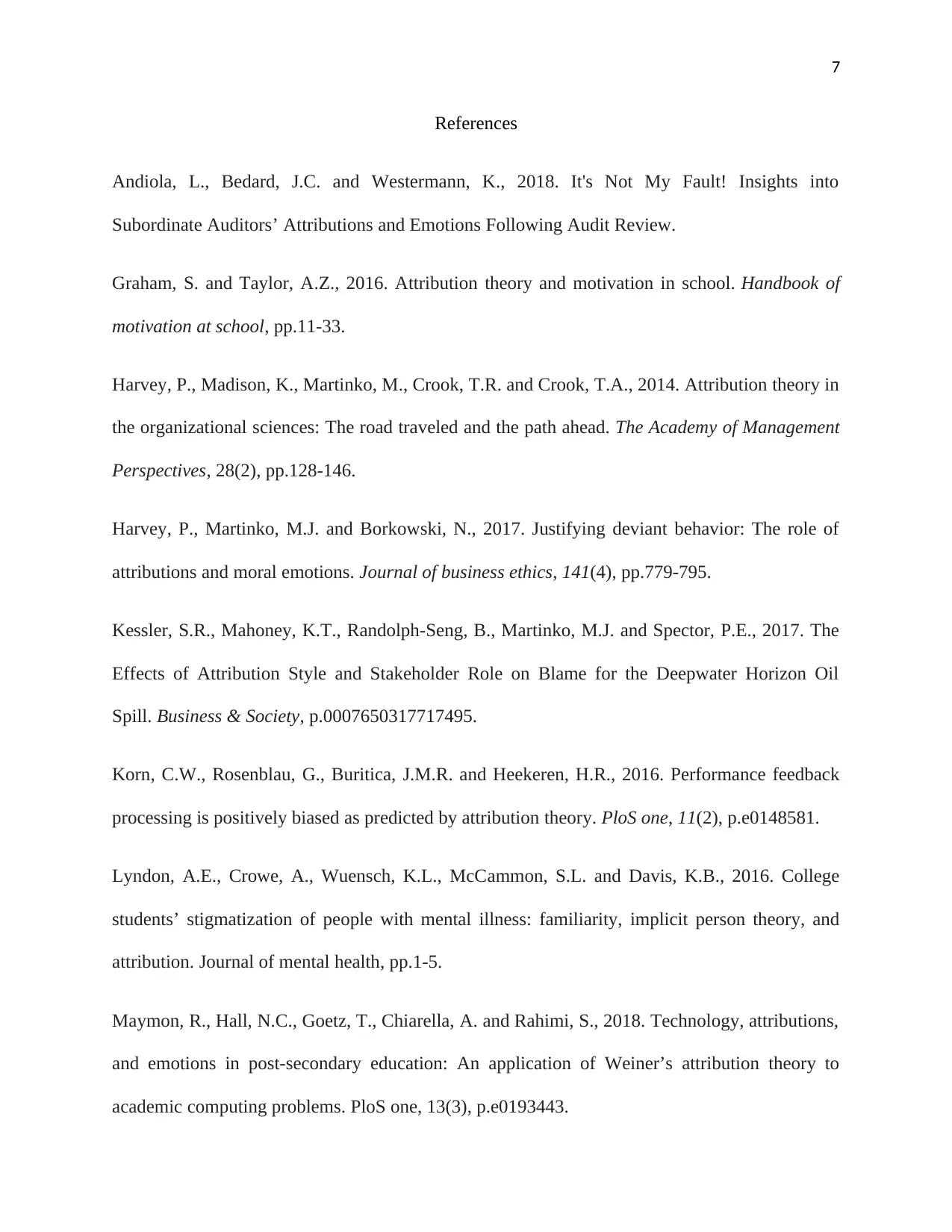
7
References
Andiola, L., Bedard, J.C. and Westermann, K., 2018. It's Not My Fault! Insights into
Subordinate Auditors’ Attributions and Emotions Following Audit Review.
Graham, S. and Taylor, A.Z., 2016. Attribution theory and motivation in school. Handbook of
motivation at school, pp.11-33.
Harvey, P., Madison, K., Martinko, M., Crook, T.R. and Crook, T.A., 2014. Attribution theory in
the organizational sciences: The road traveled and the path ahead. The Academy of Management
Perspectives, 28(2), pp.128-146.
Harvey, P., Martinko, M.J. and Borkowski, N., 2017. Justifying deviant behavior: The role of
attributions and moral emotions. Journal of business ethics, 141(4), pp.779-795.
Kessler, S.R., Mahoney, K.T., Randolph-Seng, B., Martinko, M.J. and Spector, P.E., 2017. The
Effects of Attribution Style and Stakeholder Role on Blame for the Deepwater Horizon Oil
Spill. Business & Society, p.0007650317717495.
Korn, C.W., Rosenblau, G., Buritica, J.M.R. and Heekeren, H.R., 2016. Performance feedback
processing is positively biased as predicted by attribution theory. PloS one, 11(2), p.e0148581.
Lyndon, A.E., Crowe, A., Wuensch, K.L., McCammon, S.L. and Davis, K.B., 2016. College
students’ stigmatization of people with mental illness: familiarity, implicit person theory, and
attribution. Journal of mental health, pp.1-5.
Maymon, R., Hall, N.C., Goetz, T., Chiarella, A. and Rahimi, S., 2018. Technology, attributions,
and emotions in post-secondary education: An application of Weiner’s attribution theory to
academic computing problems. PloS one, 13(3), p.e0193443.
References
Andiola, L., Bedard, J.C. and Westermann, K., 2018. It's Not My Fault! Insights into
Subordinate Auditors’ Attributions and Emotions Following Audit Review.
Graham, S. and Taylor, A.Z., 2016. Attribution theory and motivation in school. Handbook of
motivation at school, pp.11-33.
Harvey, P., Madison, K., Martinko, M., Crook, T.R. and Crook, T.A., 2014. Attribution theory in
the organizational sciences: The road traveled and the path ahead. The Academy of Management
Perspectives, 28(2), pp.128-146.
Harvey, P., Martinko, M.J. and Borkowski, N., 2017. Justifying deviant behavior: The role of
attributions and moral emotions. Journal of business ethics, 141(4), pp.779-795.
Kessler, S.R., Mahoney, K.T., Randolph-Seng, B., Martinko, M.J. and Spector, P.E., 2017. The
Effects of Attribution Style and Stakeholder Role on Blame for the Deepwater Horizon Oil
Spill. Business & Society, p.0007650317717495.
Korn, C.W., Rosenblau, G., Buritica, J.M.R. and Heekeren, H.R., 2016. Performance feedback
processing is positively biased as predicted by attribution theory. PloS one, 11(2), p.e0148581.
Lyndon, A.E., Crowe, A., Wuensch, K.L., McCammon, S.L. and Davis, K.B., 2016. College
students’ stigmatization of people with mental illness: familiarity, implicit person theory, and
attribution. Journal of mental health, pp.1-5.
Maymon, R., Hall, N.C., Goetz, T., Chiarella, A. and Rahimi, S., 2018. Technology, attributions,
and emotions in post-secondary education: An application of Weiner’s attribution theory to
academic computing problems. PloS one, 13(3), p.e0193443.
Paraphrase This Document
Need a fresh take? Get an instant paraphrase of this document with our AI Paraphraser

8
1 out of 8
Your All-in-One AI-Powered Toolkit for Academic Success.
+13062052269
info@desklib.com
Available 24*7 on WhatsApp / Email
![[object Object]](/_next/static/media/star-bottom.7253800d.svg)
Unlock your academic potential
Copyright © 2020–2025 A2Z Services. All Rights Reserved. Developed and managed by ZUCOL.


